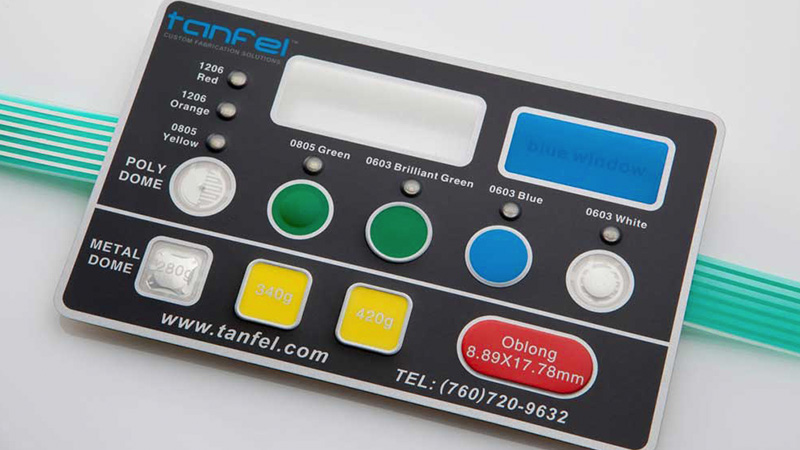Membrane Switch Over Modern Technology: The Trick to Reputable and Economical User Interfaces
Membrane switch innovation has actually emerged as a critical component in the style of individual interfaces, providing both dependability and cost-effectiveness across a varied array of applications. As we check out the multifaceted advantages of membrane buttons, their potential for innovation increases questions concerning future applications and advancing trends.
Comprehending Membrane Layer Switch Over Technology
Membrane button technology is a widely made use of interface service in various electronic tools, offering a seamless mix of performance and layout. This innovation incorporates multiple layers of materials, typically including a graphic overlay, spacer layer, and a circuit layer. The graphic overlay shows the user interface aspects, while the spacer layer divides the circuit layer from the overlay till a user activates a switch.
When stress is put on the overlay, the circuit layer finishes the electric circuit, sending out a signal to the device. This system enables numerous arrangements, consisting of responsive feedback and backlighting choices, improving individual interaction. Membrane layer buttons are typically manufactured making use of durable products such as polyester or polycarbonate, making certain durability and resistance to ecological elements like wetness and dirt.
The convenience of membrane layer switches enables their application in diverse markets, consisting of medical devices, consumer electronic devices, and commercial controls. Their compact layout enables integration into space-constrained settings, offering an effective user interface without endangering aesthetic charm. Understanding the details of membrane button modern technology is essential for producers and designers seeking to create trustworthy and efficient human-machine interfaces.
Key Benefits of Membrane Buttons
While numerous interface remedies exist, membrane layer switches offer distinctive advantages that make them a preferred choice in various applications. Among the key benefits is their sturdiness; membrane layer switches are made to withstand severe ecological conditions, including dampness, dust, and temperature level fluctuations, guaranteeing long-lasting efficiency. This resilience substantially decreases the demand for regular substitutes, thus reducing general maintenance costs.

Furthermore, membrane buttons are light-weight and compact, making them appropriate for applications where space is restricted. Their inconspicuous style contributes to a streamlined appearance without endangering functionality.
Cost-effectiveness is additionally a noteworthy advantage, as the production process for membrane layer switches has a tendency to be less costly compared to standard mechanical buttons. This cost, combined with their dependability and convenience of installment, placements membrane layer changes as a sensible solution for a large array of markets seeking effective and reliable customer interfaces.
Applications Throughout Different Industries
Just how do membrane layer switches adjust to the diverse demands of numerous sectors? Membrane layer button innovation is progressively acknowledged for its flexibility, making it appropriate for a large array of applications across multiple sectors.
In customer electronics, membrane layer buttons offer a small remedy for remotes and home devices, boosting customer experience with intuitive style. Additionally, the commercial industry leverages membrane buttons for equipment control panels, gaining from their resistance to harsh settings, such as moisture and dirt.
Armed forces and aerospace applications additionally utilize membrane buttons for their integrity and capacity to withstand extreme problems, guaranteeing functional effectiveness in essential situations. Furthermore, the food and beverage industry embraces these switches for automated systems, where cleanliness and convenience of procedure are critical. Eventually, membrane layer switches are customized to fulfill the distinct demands of each sector, confirming their necessary function in modern-day technology interfaces
Layout and Personalization Choices

In the world of membrane layer switch innovation, layout and modification alternatives play an essential function in enhancing performance and individual interaction. These buttons can be tailored to meet specific operational demands and aesthetic preferences, making them versatile parts in numerous applications.
Among the key personalization alternatives is the format of the switch itself, which can be made to fit distinct individual interfaces and ergonomic factors to consider. By readjusting the form, dimension, and plan of switches, producers can produce intuitive designs that assist in simplicity of usage. Furthermore, the incorporation of different colors and graphic overlays allows for branding and boosted presence, making sure that individuals can swiftly determine functions.
In addition, membrane layer buttons can be engineered with various tactile responses devices, such as raised buttons or distinct clicks, to boost the individual experience. Different products can also be chosen for longevity and ecological resistance, dealing with aspects such as dampness, temperature changes, and chemical exposure.
Ultimately, the extensive style and personalization alternatives readily available in membrane button modern technology encourage businesses to produce tailored options that not just fulfill functional requirements but likewise align with important source their branding and functional requirements.

Future Trends in Membrane Buttons
As membrane layer switch modern technology remains to advance, future straight from the source trends are significantly concentrated on improving customer experience and incorporating sophisticated performances. One substantial fad is the integration of touch-sensitive and capacitive technologies right into conventional membrane layer buttons. This advancement enables even more instinctive customer interfaces, giving tactile responses while preserving a smooth style.
One more arising pattern is making use of eco-friendly products, driven by the growing need for sustainable production techniques. Producers are looking for to reduce their carbon footprint by making use of recyclable substrates and low-impact inks, aligning with worldwide sustainability objectives.
Furthermore, the rise of the Internet of Points (IoT) is triggering the unification of wise features into membrane buttons. Improved connectivity choices will make it possible for devices to interact with each various other, enabling for seamless combination into broader systems.
Additionally, innovations in printing technologies, such as electronic printing, are allowing for higher layout adaptability and modification. This enables manufacturers to produce complex layouts and dynamic shades cost-effectively.

Verdict
In conclusion, membrane layer switch innovation stands for a vital advancement in individual interface design, check this supplying significant benefits in durability, customization, and cost-effectiveness. As advancements continue to emerge, specifically in touch-sensitive interfaces and lasting products, the potential for membrane layer switches over to improve user experience and capability continues to be encouraging.